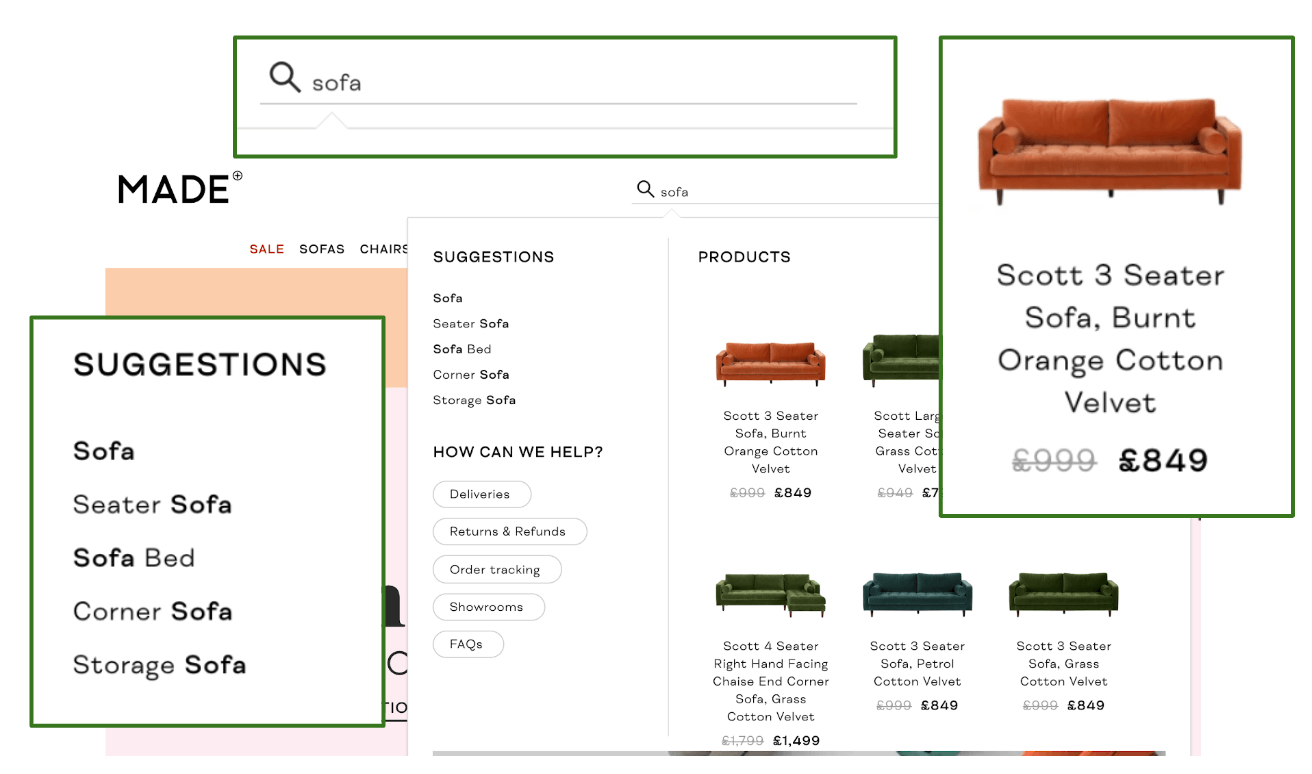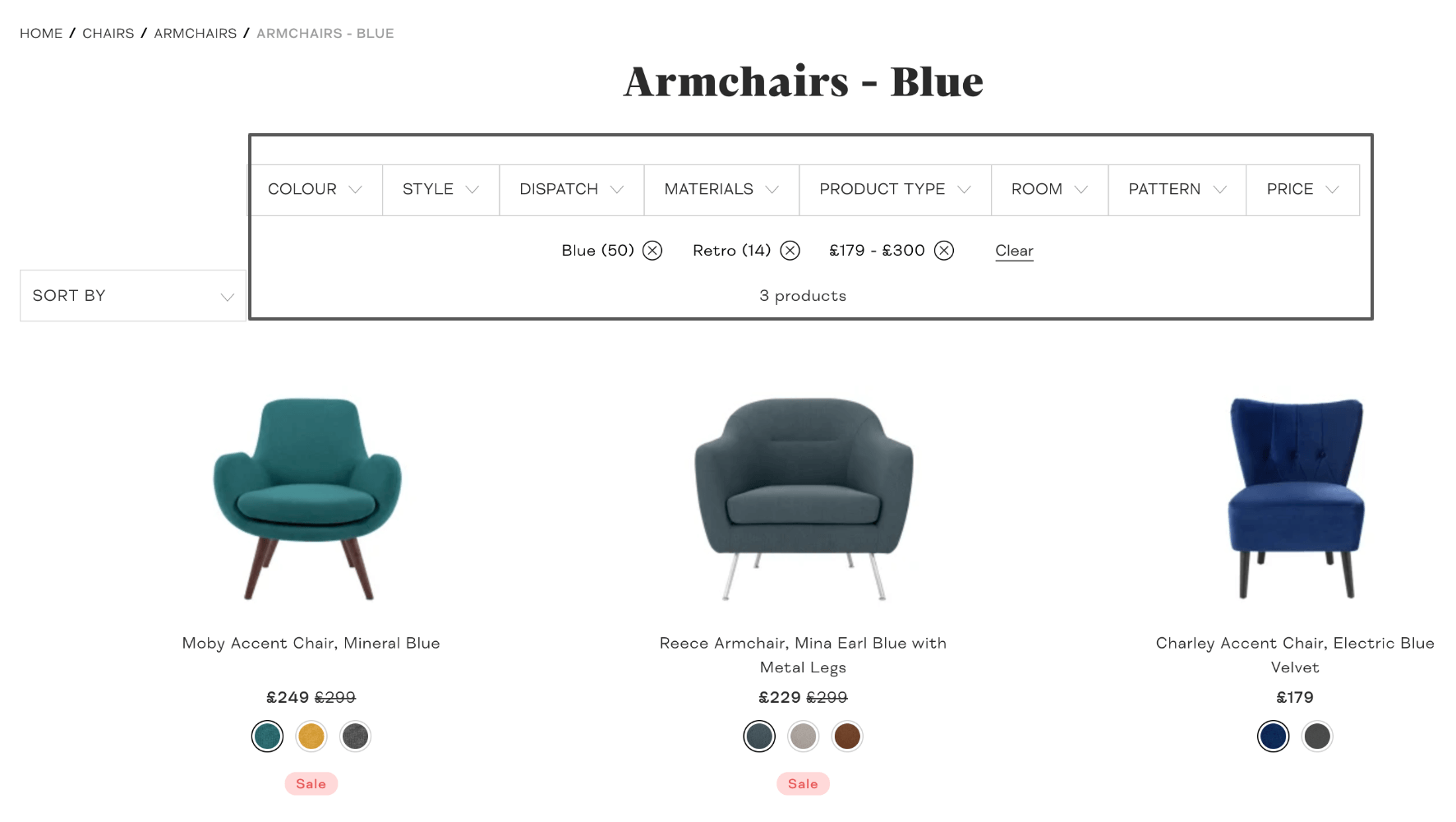How easy is it for customers to find products on your website? A seamless and simple on-site search experience is key to converting website visitors into buyers. Let’s start with why.
What is on-site search and why does it matter?
Let’s say a shopper has made it all the way to your website. Great! They type “blue wrap dress” into the search bar. Even better! Site search users are 1.8% more likely to convert than other shoppers, so this might end in a sale. But wait - the shopper’s search has resulted in a list of irrelevant product suggestions. Still motivated to find what they’re looking for, they try again but using different terms. They try “wrap-around dress” and “tie dress.” This time the results page is empty and claims to have no product matches!
Still hopeful, the shopper decides to use filters instead of the search box. They check the category as “apparel, dresses” and color “blue.” Once the filters are applied, the shopper is left with few products, none of which match the product they’re looking for. The customer now assumes that you don’t have their desired product and you’ve lost the sale.
Want to know the twist? There are actually several blue wrap dresses listed on your website as well as several similar items that the shopper may have liked. So what went wrong? The shopper couldn’t find them due to poor-quality on-site search__.
In this article, we’re going to explain why the quality of on-site search matters, how product data shapes the site-search experience, and what the future of on-site search could look like.
Why the quality of on-site search matters
The quality of on-site search plays a critical role in converting website browsers into buyers. But why? Let’s take a look.
Consumers expect intelligent site search
We’ve all been spoiled with the intelligent search capabilities of giants like Google. When searching for products on these ecommerce giants, we know we’ll be served a variety of results that are hyper-relevant to our search query. As a result, we expect the same experience when using search on smaller ecommerce sites. If a site search leaves us with little to no product matches, we expect to be served with alternative product recommendations. If a website’s search doesn’t meet these expectations, we’re likely to continue our product search elsewhere.
On-site searchers are high-value customers
Site-search users spend more on average per transaction than non-searchers. In fact, 40% of a website’s entire revenue is driven through on-site searches. This is because shoppers who search for a product on a brand’s website are more likely to have already researched products on other channels like Google. Once they land on your website, they likely have a specific product in mind and expect to find it easily through site search. That’s why an excellent site search experience will be needed in order to capture these low hanging fruits (the shoppers that are ready to buy.)
So what can you do to ensure your site search is the best it can be? That is where your product data comes in.
How great product data powers excellent on-site search
When shoppers use your site search, they use a wide range of terms in or to find the product they’re looking for. These keywords can be anything from the color to the size, type, or material of the desired product. In order for your site search to be able to associate a given search query with a specific product listing, it needs to be educated on what products are available and their characteristics. This is why it’s so important to have a clean, complete, and accurate product feed behind all of your product listings.
Let’s look at how product data impacts two popular types of ecommerce site-search: free text search and faceted search.
Free text search
What is it and how does it work?
Free text search takes place anytime a user manually types a product name or descriptive term into a search bar. This type of search allows shoppers to search the contents of a single website. Though you’re likely familiar with these type of search bars, here’s an example from furniture retailer, MADE.com.

Once a shopper makes a search, they're usually directed to one of two places. Ideally, they're directed to a specific product, brand, or category page. If there is no specific product that matches the query, they're directed to a page suggesting similar or alternative products. Importantly, retailers usually depend on a third-party search solution to integrate free text (and faceted) search onto their ecommerce site.
The role of high-quality product data in free text search
Most third-party on-site search solutions require retailers to submit a detailed product feed. The information in the feed is then indexed. When a search takes place, the search solution filters through the feed looking for relevant products that match any given query. If key product attributes are missing or there are typos in your feed, your search solution may not be able to recognize products as relevant.
How to create a perfect feed for free text on-site search
- __Enrich product titles and descriptions with relevant keywords:__ Every shopper has their own way of searching for products. Anticipate this by doing some keyword research and infusing the most popular into your feed.
- __Cleanse your feed:__ Make sure your product feed is free from common issues like typos, unnecessary HTML, and consecutive white spaces.
- __Correctly categorize your products:__ Ensure your products are all categorized correctly. For example, when a user searches for “sofa,” they should see sofas.
Here is one example of a great “sofa” search experience:

Notice how when a shopper searches for “sofa” on this particular site, they get real-time product suggestions complete with clear, compelling images, product titles, and prices. Moreover, the search even provides other suggestions that might interest the shopper.
Filtered or Faceted search
What is it and how does it work?
Another popular type of on-site search is “faceted” or “filtered” search.

Faceted search gives shoppers the option to filter results based on specific attributes or product categories like color, size, price, and so on. In the example above, we limited our search based on color, style, and price. Now, instead of skimming through 800 different chairs, we can more closely examine three that already meet our requirements as shoppers.
The role of uniform product data in faceted search
This type of search is traditionally implemented by a third-party provider. In order to work well, your product feed needs to be uniform and complete. For example, having fifteen different words for the color “blue” will make it near impossible for shoppers to find what they’re looking for. This is because when a user filters for “blue” chairs, they don’t really care at that point which shade of blue it is. They also are much less likely to search for terms like “turquoise” or “summer sky.”
How to create a uniform product feed for faceted search?
Standardize product attributes, including:
- descriptive terms
- price format
- product types
- colors
Keep in mind that these methods of site-search are not mutually exclusive and shoppers will commonly use both interchangeably.
The future of site search
The rise of AI in the consumer-centric world has generated a lot of questions about what the next big thing could be in ecommerce. Machine learning, voice search, and other buzzwords come up regularly in marketing sites and articles. But if we look more closely, we could ask the same questions about what’s next for on-site search.
In fact, upon closer inspection, AI and deep learning are already being incorporated into some on-site search tools. Search provider, Syte, for example, uses machine learning to provide image recognition-powered search for ecommerce websites. With this search solution, shoppers can upload an image of a product they like and get results based on the product’s attributes. This works especially well when a user isn’t sure how to describe the product or if they want to search for an entire outfit rather than just one piece.
Then there is voice search. While it is often associated with Amazon or Google, it could very well be used for site search on smaller ecommerce sites in the future.
In order to ensure your business is ready for what may come, having a product feed that is high-quality, uniform, and search-ready is key.
Productsup and on-site search
Ecommerce site search providers serve to list the most relevant results for a product search on a retailer’s website. By bringing the right product to the shopper, these solutions play a crucial role in generating sales. In order to provide the best results, all the necessary product information needs to be handed over in a specific file and format to the search service. This is where Productsup comes in.
With Productsup, brands and online retailers can quickly and easily create a high-quality and uniform product feed. Want to standardize product colors or terms in your product feed? Our platforms lets you do that in just minutes. Need to structure your feed to match the specifications of your on-site search solution? No problem! Productsup provides all the tools you need to tailor the perfect feed and export it to search provider of your choosing. Don’t see the provider you’re looking for? Let us know and we’ll integrate an export template for you!
Want to take your on-site search efforts even further? Try importing performance analytics data and merging it into your main feed on Productsup. By applying a single rule, you can use this data to boost the search rank of your highest performing products!

![[WP Import] How high-quality product data powers phenomenal on-site search](http://images.ctfassets.net/q17uls4wkkdz/60NfdTO9usAXNqhtELnpzC/f6bbd01134dd101a6d358d12b263307f/19-07-08_How_high_quality_product_data_powers_on-site_search_ft_image_800x500.png?w=1200&h=675&fit=FILL)